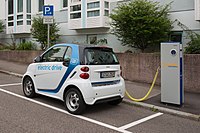IEC 61851

IEC 61851 is an international standard for electric vehicle conductive charging systems, parts of which are currently still under development(written 2017). IEC 61851 is one of the International Electrotechnical Commission's group of standards for electric road vehicles and electric industrial trucks and is the responsibility of IEC Technical Committee 69 (TC69).[1]
Standard documents
IEC 61851 consists of the following parts, detailed in separate IEC 61851 standard documents:
- IEC 61851-1: General requirements[2]
- IEC 61851-21-1: Electric vehicle on-board charger EMC requirements for conductive connection to AC/DC supply[3]
- IEC 61851-21-2: Electric vehicle requirements for conductive connection to an AC/DC supply - EMC requirements for off board electric vehicle charging systems[4]
- IEC 61851-23: DC electric vehicle charging station[5]
- IEC 61851-24: Digital communication between a DC EV charging station and an electric vehicle for control of DC charging[6]
- IEC 61851-25: DC EV supply equipment where protection relies on electrical separation[7]
IEC 61851-1
IEC 61851-1 defines four modes of charging:
| Mode | Diagram | Limits | Supply & Interface | RCD Protection | Applications | Notes | ||
|---|---|---|---|---|---|---|---|---|
| Phases | Current | Voltage | ||||||
| 1 | EV connected directly to AC grid |
1φ | 16A | 250V | AC, non-dedicated | electric bikes, scooters, trickle-charging | Direct connection of vehicle to conventional electrical outlets. Not allowed in the US, Israel, and United Kingdom; prohibited for public charging by Italy; restricted in Switzerland, Denmark, Norway. | |
| 3φ | 16A | 480V | ||||||
| 2 | EV connected to AC grid through cable incorporating RCD protection |
1φ | 32A | 250V | AC, non-dedicated | "slow AC" | Requires control box between vehicle and electrical outlet incorporating RCD protection. Prohibited for public charging by Italy; restricted in US, Canada, Switzerland, Denmark, France, Germany and Norway. Typical portable / "home" charger. | |
| 3φ | 32A | 480V | ||||||
| 3 | EVSE connected to AC grid, supplies EV using tethered cable or socket-outlet with bidirectional communication |
1φ | 32A | 250V | AC, dedicated (IEC 62196-2) | "slow and quick AC" | EVSE permanently connected to electrical grid; includes RCD protection and bidirectional (EVSE/EV) communication. Typical public AC charger installation. Tethered (cable permanently attached) & untethered (dedicated socket outlet only) configurations. | |
| 3φ | 32A | 480V | ||||||
| 4 | EVSE rectifies AC grid & supplies DC power to EV using tethered cable with bidirectional communication |
– | 200A | 400V | DC, dedicated (IEC 62196-3) | "fast DC" | Current conversion handled by EVSE, not EV. | |
References
- ^ IEC Technical Committee 69
- ^ IEC 61851-1
- ^ IEC 61851-21-1
- ^ "IEC 61851-21-2:2018 | IEC Webstore".
- ^ IEC 61851-23
- ^ IEC 61851-24
- ^ IEC 61851-25
- ^ "Charging modes (IEC-61851-1)". Circutor. Retrieved 10 August 2021.
- ^ Ferrari, Lorenzo. "Charging modes for electric vehicles". Daze Technology. Retrieved 10 August 2021.
- ^ "Guide to Electric Vehicle Infrastructure" (PDF). Association for the British Electrotechnical Industry (BEAMA). May 2012. Retrieved 23 August 2022.
See also
- ISO 15118 - Standard defining a vehicle to grid (V2G) communication interface for bi-directional charging/discharging of electric vehicles
- IEC 61850 - Communication protocols for intelligent electronic devices at electrical substations
- IEC 61851 - Standard for electric vehicle conductive charging systems
- IEC 62196 - A series of international standards that define requirements and tests for plugs, socket-outlets, vehicle connectors and vehicle inlets
- IEC 63110 - Protocol for the management of electric vehicles charging and discharging infrastructure
- OpenEVSE


